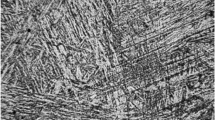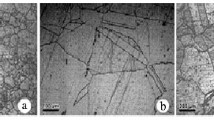Abstract
Measurements of the threshold stress intensity for hydrogen-induced crack extension,Kth at room temperature were made on bolt-loaded WOL specimens of a commercial 4340 steel and of laboratory heats in which the bulk concentrations of manganese, silicon, phosphorus, and sulfur were varied. The hydrogen pressure was varied from 200 to 1600 torr (~0.03 to 0.22 MPa), and the yield strengths were varied from ~170 to 270 ksi (~1200 to 1900 MPa). Measurements ofKIc in air were also made as a function of composition and yield strength. Significant differences betweenKIc in air andKth in H2 were found only in steels containing added Mn or Si; these elements are believed to promote segregation of phosphorus and sulfur to austenite grain boundaries. TheKth values were uniquely related to the percentage of intergranular fracture and also to a parameter containing the calculated maximum hydrogen concentration and the bulk concentrations of manganese, silicon, phosphorus, and sulfur. In a high purity steel free of manganese and silicon theKth was lower thanKIc only at yield strengths greater than 200 ksi (1400 MPa). The results are consistent with an additive reduction in cohesive strength by hydrogen and metalloid impurities. It is shown that theKth depends on hydrogen fugacity, yield strength, and grain boundary purity(i.e., cohesive strength).
Similar content being viewed by others
References
A. R. Troiano:Trans. ASM, 1960, vol. 52, p. 54.
U. Q. Cabrai, A. Hache, and A. Constant:C.R. Acad. Sci., Paris, 1965, vol. 260, p. 6887.
D. P. Williams and H. G. Nelson:Metall. Trans., 1970, vol. 1, p. 63.
R. A. Oriani:Ber-Bunsen-Geselsch. Phys. Chem., 1972, vol. 76, p. 848.
K. Yoshino and C.J. McMahon, Jr.:Metall. Trans., 1974, vol. 5, p. 363.
R. A. Oriani and P. H. Josephic:Acta Metall., 1974, vol. 22, p. 1065.
W.W. Gerberich and Y.T. Chen:Metall. Trans. A, 1975, vol. 6A, p. 271.
J. F. Lesser and W. W. Gerberich:Metall. Trans. A, 1976, vol. 7A, p. 953.
R. Viswanathan and S. J. Hudak, Jr.:Metall. Trans. A, 1977, vol. 8A, p. 1633.
G.W. Simmons, P.S. Pao, and R. P. Wei:Metall. Trans. A, 1978, vol. 9A, p. 1147.
S. K. Banerji, C. J. M Mahon, Jr., and H. C. Feng:Metall. Trans. A, 1978, vol. 9A, p. 237.
C. L. Briant, H. C. Feng, and C. J. McMahon, Jr.:Metall. Trans. A, 1978, vol. 9A, p. 625.
Y. Takeda and C. J. McMahon, Jr.:Metall. Trans. A, 1981, vol. 12A, p. 1255.
Jun Kameda, N. Bandyopadhyay, and C. J. McMahon, Jr.: Proc. Int. Symp. on “Hydrogen in Metals”, Minakami, Japan, 1979,Trans. JIM, 1980, vol. 21, p. 437.
H. Mabuchi and C.J. McMahon, Jr.:ibid.,, p. 441.
Jun Kameda and C.J. McMahon, Jr.:Metall. Trans. A, 1981, vol. 12A, p. 31.
S.R. Novak and S.T. Rolfe:J. of Materials, 1969, vol. 4, p. 701.
K. Farrell and A. G. Quarrell:J. Iron Steel Inst., 1964, vol. 202, p. 1002.
N. Bandyopadhyay and C.J. McMahon, Jr.: Metall. Trans. A, in press.
W.G. Clark, Jr.: Westinghouse Research Laboratories, Scientific Paper 75-1E7-MSLRA-P1.
CM. Li, R.A. Oriani, and L.W. Darken:Z. Phys. Chem., 1966, vol. 49, p. 271.
H. Wagenblast and H.A. Wriedt:Metall. Trans., 1971, vol. 2, p. 1393.
J.P. Hirth:Metall. Trans. A, 1980, vol. 11A, p. 861.
N. R. Quick and H. H. Johnson:Acta Metall., 1978, vol. 26, p. 906.
J.R. Rice and M.A. Johnson:Inelastic Behavior of Solids, M.F. Kanninen, ed., McGraw-Hill, New York, NY, 1970, p. 164.
Jun Kameda and C.J. McMahon, Jr.:Metall. Trans. A, 1983, vol. 14A, p. 903.
B.C. Edwards: Intnl. Sympos. on Defects and Fracture, Krakov, Poland, October 1980.
J. Shin, Jun Kameda, and C. J. McMahon, Jr.: Symposium on Micro and Macromechanisms of Crack Growth, Fall Meeting TMS-AIME, Louisville, KY, October 1981, in press.
P. Jolly and C. Goux:Mem. Sci. Rev. Met., 1969, vol. 66, p. 605.
S.M. Bruemmer, R. H. Jones, M.T. Thomas, and D.R. Baer: Fall Meeting TMS-AIME, Louisville, KY, October 1981.
M. L. Jokl: University of Pennsylvania, unpublished research, 1981.
Jun Kameda and M. L. Jokl:Scripta Metall., 1982, vol. 16, p. 325.
Author information
Authors and Affiliations
Additional information
Formerly with the Department of Materials Science and Engineering, University of Pennsylvania
Rights and permissions
About this article
Cite this article
Bandyopadhyay, N., Kameda, J. & Mcmahon, C.J. Hydrogen-induced cracking in 4340-type steel: Effects of composition, yield strength, and H2 pressure. Metall Trans A 14, 881–888 (1983). https://doi.org/10.1007/BF02644292
Received:
Issue Date:
DOI: https://doi.org/10.1007/BF02644292




